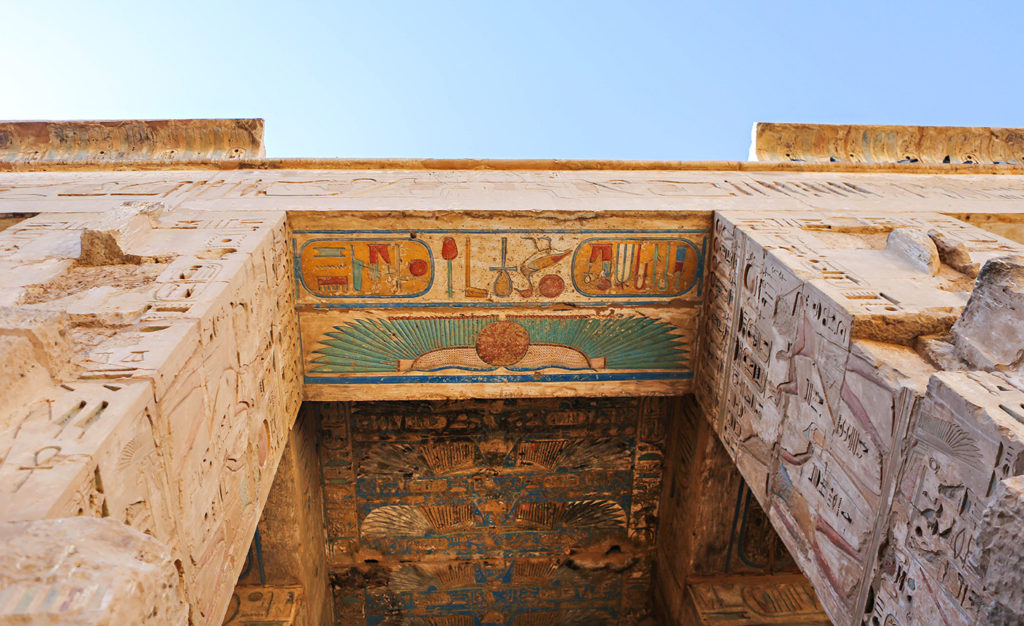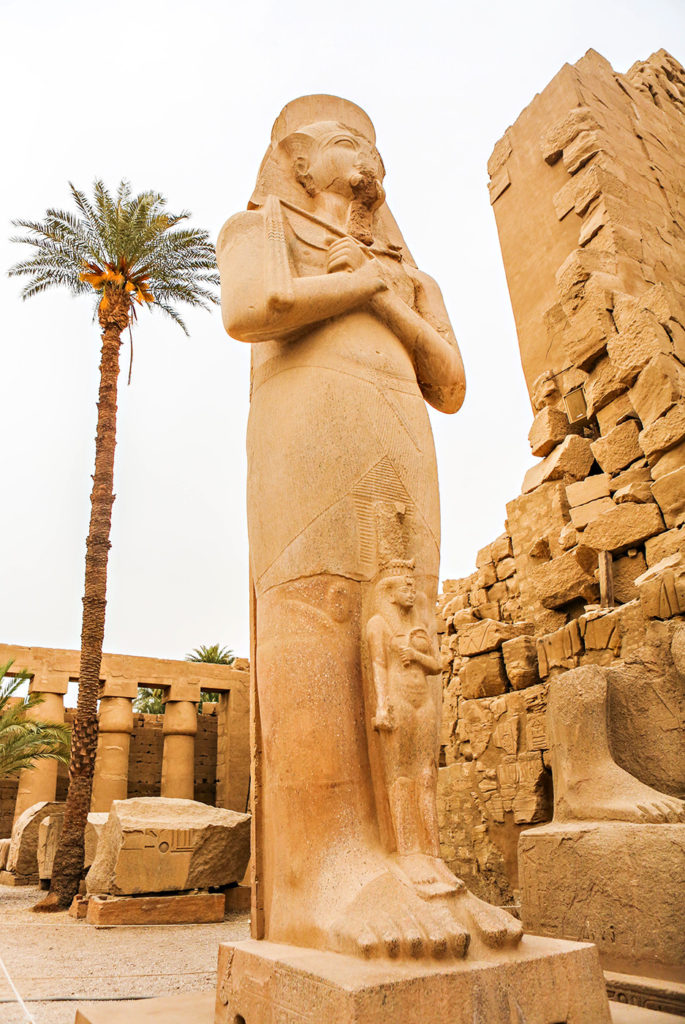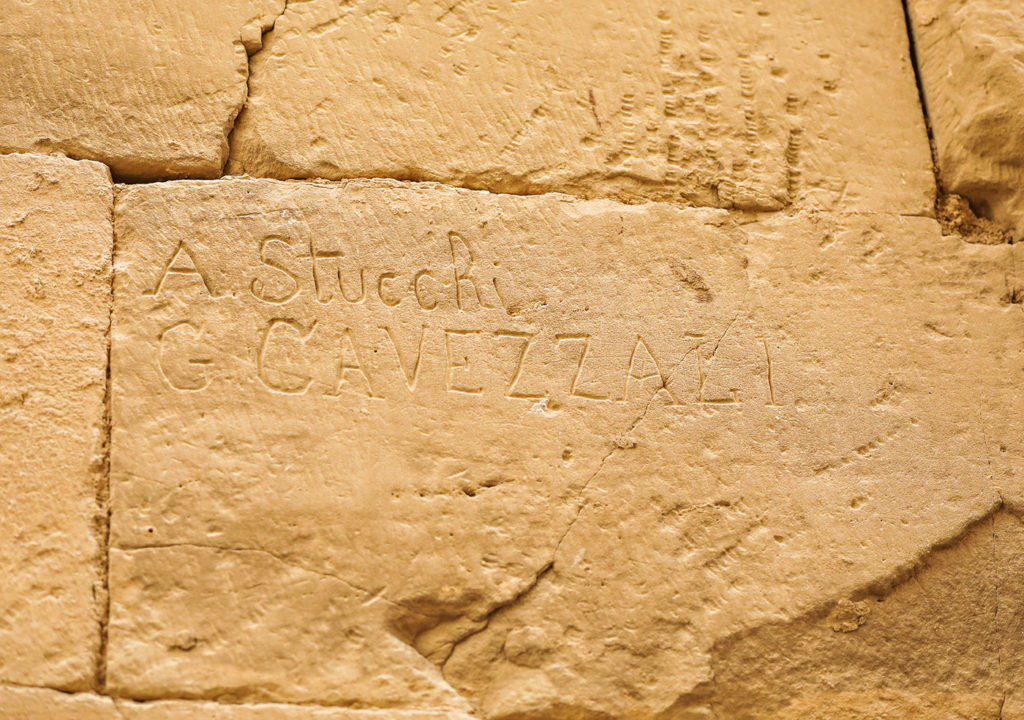We started in Cairo, Egypt… and headed to Giza to see the famous Pyramids. As widely known, these are the funerary structures of the three great pharaohs, Menkaure, Khafre and Khufu. The Great Pyramid of Khufu is is the largest pyramid in Egypt, the only one of the Seven Wonders of the Ancient World remaining. You can see the city of Cairo in the distance.
All photos are (c) julie shipman photography 2017
The shape of Egyptian pyramids is thought to represent the primordial mound from which the Egyptians believed the earth was created and of the descending rays of the sun. Most pyramids were faced with a polished, highly reflective white limestone, in order to give them a brilliant appearance when viewed from a distance.
The Egyptians believed the dark night sky was the physical gateway into the heavens. The narrow shaft that extends from the main burial chamber through the entire body of the Great Pyramid points directly toward the sky. You can see this below. This suggests the pyramid may have been designed to serve as a means to launch the deceased pharaoh’s soul directly into the heavens. Of course, most of this is modern day assumptions!
All Egyptian pyramids were built on the west bank of the Nile, where the setting sun was associated with the realm of the dead. The sun rises in the East so the East side of the Nile was for the Living and the major cities were built there. The West side of the Nile was for the Dead so the Funerary Temples and Tombs are all along the West Bank.
This photo provides some perspective as to how large the stones are. It is truly spectacular to stand beside these gigantic structures and imagine how they were built.
Moving south to the West Bank of Luxor, below is the relatively under-acclaimed Medinet Habu Temple. This is Ramses III’s Memorial Temple. The intense colors and exceptionally preserved hieroglyphs make this place really phenomenal. It is also known for the detailed reliefs depicting the arrival and defeat of the “Sea Peoples” who arrived across the Mediterranean. In some places you can even see where their various body parts (including their genitalia!) were removed and placed in piles! Ooh la la!
You will notice that I’m drawn to birds in these photos. I find that when you have something static (as an ancient building) in a photo, a little life adds interest to an otherwise possibly boring photo… and it provides perspective. Enjoy!
The color still seen in these reliefs is truly remarkable. After approximately 5000 years, their natural paint still holds. Also interesting at this temple is the unusual depths of the hieroglyphs. Apparently, Ramses III was a man of great ego. He wanted his writings to last the ages so he ordered them cut deeper than was customary. And, last they did…








 I just love these sandals. Honestly, has fashion changed much in 5000 years? I think Tori Burch could produce these today in maybe a nice red leather bottom with a stunning white suede strap?
I just love these sandals. Honestly, has fashion changed much in 5000 years? I think Tori Burch could produce these today in maybe a nice red leather bottom with a stunning white suede strap?
…On to the more recognizable Temple of Hatshepsut, another Funerary Temple, as we are still on the West Bank. This temple is remarkable not only for its amazing structure but because it is for the first female ruler of Egypt, Queen Hatshepsut (or Hot Chicken Soup as the British like to call her…). Apparently the pyramid-shaped mountain in the background attracted her as tradition dictated. Pyramids were no longer being built due to cost and exposure at that time.
In Egyptian hieroglyphics, a cartouche is an oval with a horizontal line at one end, indicating that the text enclosed is a royal name.
Below is Anubis, the name of the god associated with mummification and the afterlife, usually depicted as a man with a canine (or a jackal) head. Anubis assumed different roles in various contexts. He is depicted as a protector of graves as early as the First Dynasty (c. 3100 – c. 2890 BC), but Anubis was also an embalmer. One of his prominent roles was as a god who accompanied the souls into the afterlife. He attended the weighing ceremony during the “Weighing of the Heart,” in which it was determined whether a soul would be allowed to enter the realm of the dead. Anubis was depicted as black, a color that symbolized both rebirth and the discoloration of the corpse after embalming.
I’m also intrigued by the beautiful stars painting in gold on blue. While early Egyptologists thought they were ‘just stars in the sky,’ later theory holds that they actually represent the souls who have arrived in heaven. You find this on ceilings all over the mortuary temples.
You can see more cartouches below, this time horizontal. They could be represented in either direction, usually determined by the relief itself and what direction worked in the space.
As you stand at the Temple of Hatshepsut, you see smaller graves going into the mountains surrounding the area. These are typically known as the Tombs of the Workers. These housed the artists, craftsmen, and workers who built and ornamented the royal tombs.
The craftsmen who lived in the area were divided into two squads and each team used to work for 8 hours a day with the right to take two days off every eight days. For years, it was assumed the pyramid and tomb builders were slaves, but this is not true. With a supervisor, each squad consisted of 15 to 30 individuals who worked in the same time on both sides of the tomb digging with the use of hammers made out of wood and bronze. As the builders started working their way into the mountain, the craftsmen would trim and smooth out the walls. They would add a layer of a mixture of sand, clay, and straw and then another layer of plaster mixed water. After the preparation of the walls was completed, the artists would begin their work drawing with red ocher or charcoal. After the drawing, the sculptors would carve the rock into reliefs. Then the decorators would color the bas reliefs with different paints of natural origin.
While the diggers were still working in the outer part of the tomb, other sections of the tomb further in were already completed. I was intrigued as to how they had light to see in the depths of the tombs. It is thought they used mirrors to reflect in angular patters that lit up the walls below. So cool! They don’t believe candles were used much because they cannot find residue in the ceilings and the oxygen was needed for the workers.
So, situated on the slopes of the mountains near the vast royal tombs, the workers and artists who constructed them, were buried near their greatest work. These tombs, much smaller than the royal tombs of the Valley of the Kings and Queens, were also fascinating and beautiful, just on a smaller scale.
Perhaps the most beautiful and breath-taking tombs I saw were in the Valley of the Kings, including the pristine tomb of King Tut, the only tomb discovered intact, not being ravaged by the many thieves who stole the valuable gold artifacts left to accompany their royal leaders into the afterlife. Cameras are not allowed into the Valley of the Kings, so look it up on-line, or better yet, go visit yourself!
Next, crossing the Nile to the East Bank in Luxor, I visited the Karnak and Luxor Temples… of the Living as they are on the EAST bank, where the Sun Rises!! Luxor is the ancient city of Thebes and El Karnak is a village just north of modern day Luxor. The entire complex is quite astounding as it is a vast open-air museum, the second largest ancient religious site in the world, after Angkor Wat. Karnak is unique not only in size, but in its length of use. The temples were built in the Middle Kingdom and used through to Ptolemaic Times… estimated to be around 30 pharaohs contributing to its buildings.
As you enter, you see the Way of the Rams, an avenue leading into the Karnak Temple. It is attributed to Rameses II because they contain his cartouche, or royal signature. The ram is thought to have protected the pharaoh as his statuette is being guarded by his body between his massive lion-bodied paws.
The statues are enormous. I included the man’s head to provide relative size!
Below one of the several massive and impressive obelisks at Karnak. An obelisk is a four-sided tapering shaft with a pyramidal top, originally erected in pairs at the entrances of ancient Egyptian temples. It was carved from a single piece of stone, usually red granite from the quarries at Aswan. This one is thought to be the Obelisk of Queen Hapshetsut, perhaps one of four erected at the entrance to pay homage to the Sun God. Our guide, Amel, told us they were built and carved by creating ramps up the sides and working their way down as they removed the stone and sand from the sides. However they were done, they are massive and impressive by any standards. This one is the tallest surviving ancient obelisk on earth, the others toppled and broken.
Below is a massive statue of Rameses II wearing the double crown of Upper and Lower Egypt (indicating rule of both) and his arms are crossed holding the royal symbols of the crook and flail. It is believed the female statue on his feet is Princess Bentanta, daughter of Isetnofret, one of Rameses II most important wives.
Believed to have originated with Hatshepsut, the Great Hypostyle Hall inside the Karnak Temple is almost mind-boggling. It covers an area of 50,000 sq.ft. and has 134 columns in 16 rows which once supported a roof. Walking among these massive structures is overwhelming. It’s so awesome James Bond, 007 even adventured there in the Spy who Loved Me! Check it out!!!! (I think they incorporated a bit of Habu in there at the end but I could be wrong!)
https://www.youtube.com/watch?v=frbKPmC_soA
Below is the sacred beetle or the Scarab, a well-known symbol for ancient Egypt. Here he is atop a column we were told to walk around and make a wish for good luck! More often, you see them inscribed in hieroglyphs or worn as jewelry/amulets. In ancient Egyptian religion, the sun god Ra is seen to roll across the sky each day, transforming bodies and souls. Certain types of beetles roll dung into a ball as food and as a brood chamber in which to lay eggs; this way, the larvae hatch and are immediately surrounded by food. For these reasons the scarab was seen as a symbol of this heavenly cycle and of the idea of rebirth or regeneration. And it is worn as an amulet to bring good luck, or rebirth each day.
And finally we visited the Temple at Luxor, right in the middle of the city, along the Nile — with the entrance again lined with sphinx. Luxor Temple was constructed approximately 1400 BCE. Unlike the other temples in the area, Luxor temple is not dedicated to a cult god or a deified version of the king in death. Instead, Luxor temple is dedicated to the “rejuvenation of kingship”; it may have been where many of the kings of Egypt were crowned.
Below is another enormous and stunning statue of Ramses II. Incidentally, the straight beard represents a living pharaoh while a beard that is curved at the end means a deceased pharaoh, more often seen at the Mortuary Temples. I love the rather diminutive statue of his “beloved wife” Queen Nefertari at his side, of course represented as much smaller in size, therefore importance. Nevertheless, her arm placement shows her vital support of him and his reign.
And finally, one of the most interesting reliefs at the Temple of Luxor: the Christians. No, Ramses II did not order a depiction of the apostles paying homage to their King. This is an example of ‘ancient’ graffiti, although much less ancient than the Egyptian reliefs and inscriptions in abundance in Ancient Thebes. Alexander the Great invaded Egypt and later the Romans. And, afterwards, Christians took over many of the ancient temples to make them places of worship to Christ. Even many mountain tombs were made into monasteries for Christian monks. But below, you can see the fresco painted over the ancient Egyptian reliefs, a sign to me that humans want to continually make their mark — then and now…
When does graffiti become ART? When is it to be preserved as a RELIC? So interesting! I saw signs of ‘modern’ (19th century) graffiti all over the ancient sites, most of it from the early 1800s when European travelers and archeologists went to Egypt. Take a look at some of the signatures/carvings below; you can determine their nationalities by their names and inscriptions… I found English, French, German, Italian, Greek and Polish, but I’m sure I missed a few. Also interesting is how high up their writings are due to the continued excavation over the last hundred years. Most ancient Egyptian sites are still thought to be underground as it is believed less than 25% have been discovered. So much more to come! I, for one, will be back to see it…

Thanks for enjoying with me! Next blog on the beautiful people I met on my journey…







































